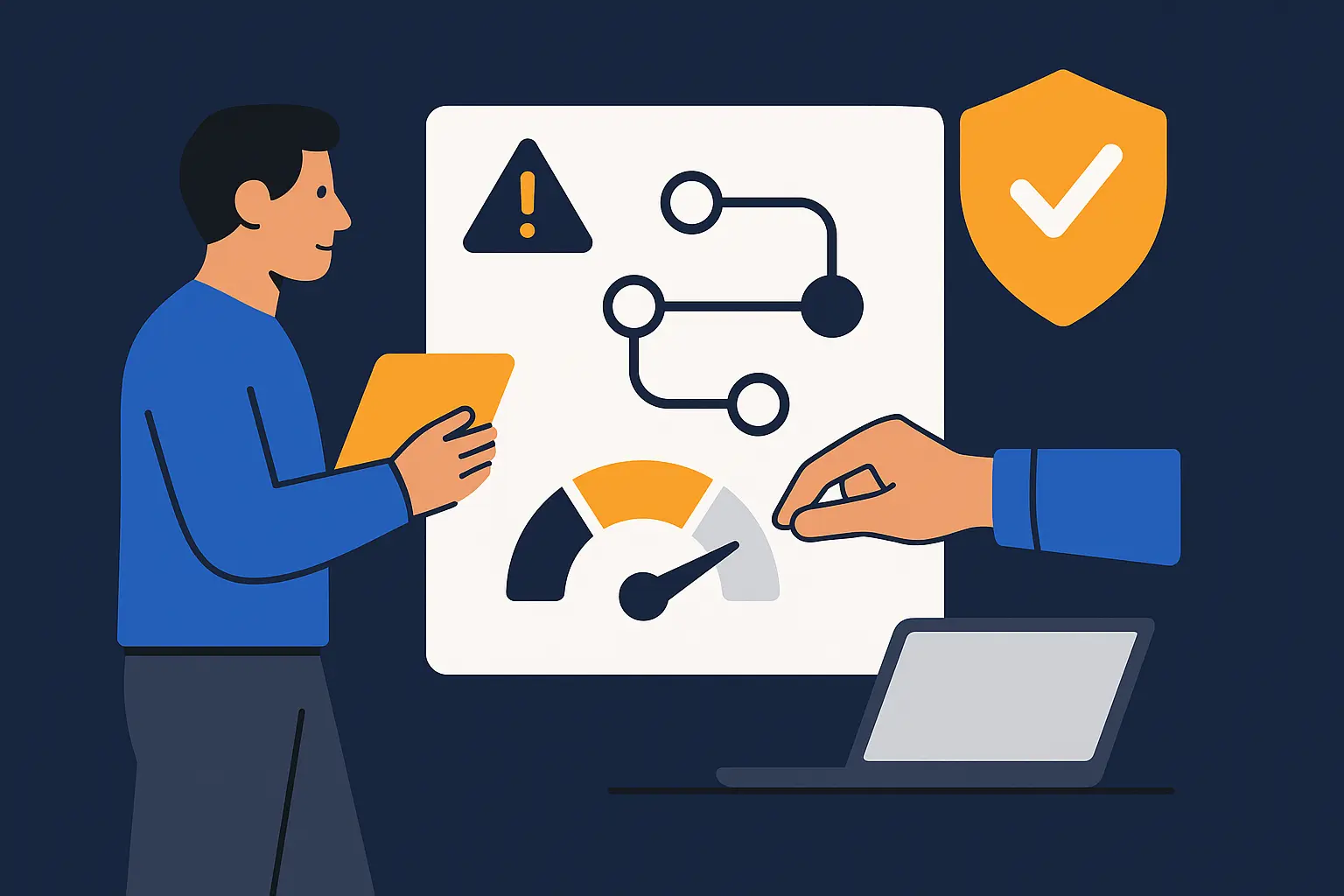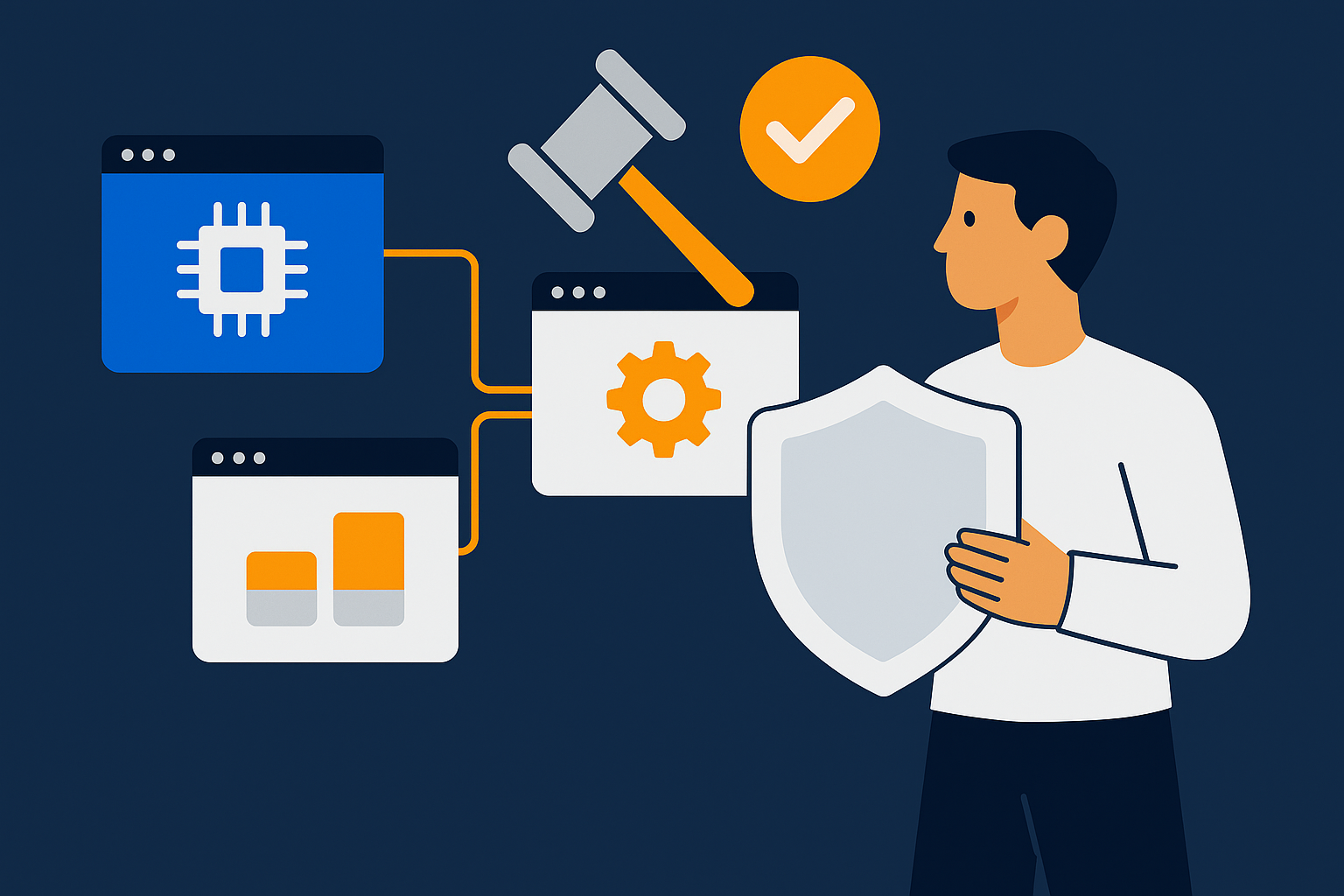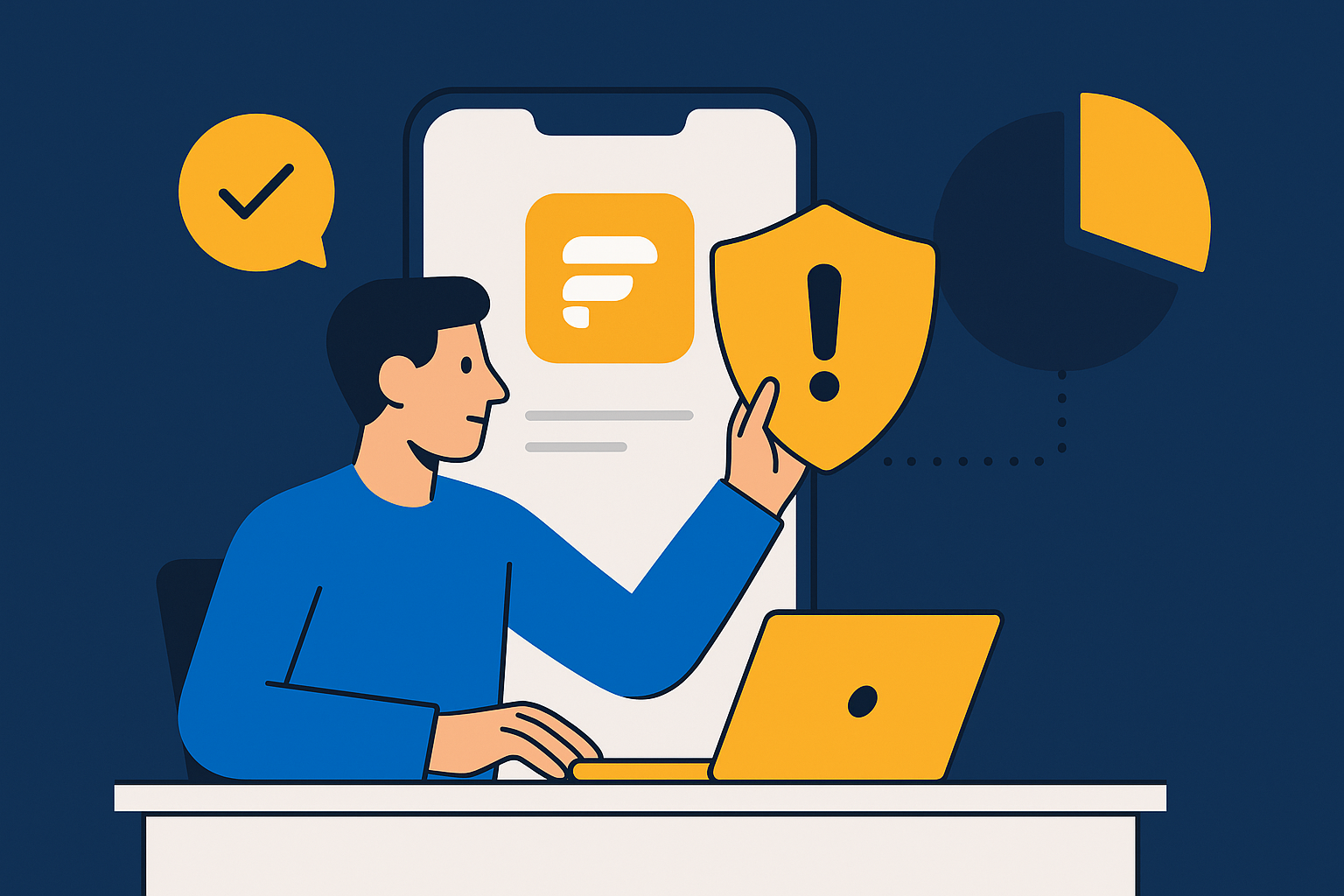Introduction

Most product roadmaps are still built as ranked feature wishlists. They’re easy to pitch and easy to misunderstand—and they rarely survive contact with enterprise realities like regulatory gates, identity and data controls, procurement, or scale. Features ship, but audit findings, outages, and hidden integration costs pile up. Budget owners ask the same question: why did we fund a “v1” that still isn’t deployable?
At CoreLine, we help executives turn post‑MVP ambition into production‑ready web and mobile platforms. A pattern we see across industries is simple and solvable: teams prioritize by perceived market value alone, not by risk. The outcome is predictable—schedule slips, emergency rework, and a higher total cost of ownership.
This article presents a practical, CFO‑ready approach: the risk‑weighted roadmap. Instead of sorting only by business impact, you sequence work by its ability to remove risk that blocks revenue, compliance, reliability, or velocity. The method is fast to adopt, transparent for stakeholders, and repeatable across product lines.
Event/Performer Details

- Audience: CEOs, CTOs, CPOs, product leaders, heads of engineering, and marketing directors responsible for go‑to‑market timing and post‑MVP scale.
- What you’ll get: a 6‑step method, templates to quantify risk, examples mapped to enterprise application development, and governance patterns that withstand audits.
- What this is not: another MVP checklist or design sprint recap. Many agencies already cover those well; you’ll find primers on MVP scope and sprinting elsewhere. We focus on an underrepresented gap—tying roadmap decisions directly to quantified risk, procurement, and operational readiness for complex platforms. (thoughtbot.com)
Why You Shouldn’t Miss It
- Converts “nice‑to‑have” governance into measurable ROI (reduced rework, faster approvals, fewer incident costs).
- Builds shared language for C‑suite, product, design, and engineering.
- Makes enterprise constraints (SSO, data residency, observability, privacy) part of the value conversation.
- Lowers TCO by sequencing foundational work before high‑variance features.
- Works for custom web applications, mobile apps, and platforms—independent of tech stack or vendor.
What Competitors Cover—and the Content Gap We’re Filling
Many leading agencies publish high‑quality guidance on MVPs, design practices, accessibility, and product acceleration. Thoughtbot, for example, shares actionable advice on defining and prioritizing MVP features; Foolproof outlines UX strategy and roadmapping; Endava highlights product acceleration; and Infinum invests heavily in accessibility education. These are valuable—yet few tie executive budgeting directly to a quantified, risk‑weighted roadmap that aligns procurement, compliance, UX, and engineering into one decision model. That’s the gap this playbook addresses. (thoughtbot.com)
The Case for Risk‑Weighted Roadmaps
A risk‑weighted roadmap prioritizes work that eliminates the biggest blockers to revenue and scale. Unlike pure “impact” scoring, it accounts for:
- Launch risk: items that, if ignored, prevent production release (e.g., SSO/SAML readiness, data processing agreements, app store compliance).
- Operability risk: items that, if deferred, create outages or toil (SLOs, error budgets, observability, runbooks, on‑call).
- Compliance risk: items tied to audits, privacy, security reviews (PII minimization, consent flows, encryption at rest/in transit, RBAC).
- Financial risk: items that silently expand cloud spend or vendor lock‑in (egress fees, multi‑region replication, third‑party pricing cliffs).
- UX and adoption risk: items that undermine activation, task success, or trust (navigation debt, accessibility gaps, inconsistent design tokens).
By removing these risks early, you increase the probability that later features actually convert. In short: you de‑risk revenue.
A 6‑Step Method You Can Run in Two Workshops
1) Define success constraints
Beyond OKRs, capture non‑negotiables that define “releasable” for your organization:
- Security: compliance framework, pen‑test window, secrets management.
- Data: retention, residency, DPA/SSA status, backup/RTO/RPO.
- Identity: SSO/SAML/OIDC, SCIM provisioning, role models.
- Ops: SLOs and initial error budgets, logging/metrics/tracing, incident process.
- UX: accessibility level (e.g., WCAG 2.2 AA), task‑success targets, localization.
Codify these as gates in your roadmap so they’re visible and funded, not “we’ll do it after v1.”
2) Inventory risks
Create a risk register tied to your product’s context. For each risk, note:
- Description and category (Launch/Operability/Compliance/Financial/UX).
- Likelihood (1–5), Impact (1–5) on revenue, time, or regulatory exposure.
- Exposure score: Likelihood × Impact.
- Mitigation: the smallest meaningful deliverable (an epic or spike) that reduces exposure.
3) Quantify risk weight
Assign a Risk Weight (RW) to each mitigation:
- RW = Exposure Score × Time‑to‑Mitigate multiplier.
- Apply multipliers for dependencies or deadlines (e.g., app store review dates, contract renewals).
- Normalize on a 0–100 scale to compare across tracks (engineering, UX, data).
This is not bureaucracy; it’s a way to explain to finance why a two‑week “SSO hardening” epic outranks a three‑month “dashboard v2.”
4) Map mitigations to epics you already understand
Translate risks into work your teams can ship:
- Launch: “SCIM user lifecycle v1,” “Privacy consent UI baseline,” “AppStore privacy nutrition labels.”
- Operability: “Golden signals + alert routes,” “Runbook v1,” “Canary deploys + feature flags.”
- Compliance: “PIA/DPIA complete + records of processing,” “KMS rotation,” “RBAC audit.”
- Financial: “Cost guardrails—budgets + anomaly alerts,” “S3/egress audit + caching strategy.”
- UX: “Critical task flow test > 80% success,” “WCAG 2.2 AA fixes for core journeys,” “Design tokens v1.”
5) Sequence with RW‑RICE
Blend risk into the familiar RICE model (Reach × Impact × Confidence ÷ Effort). Use:
- RWR (Risk‑Weighted Reach): how many users or transactions are at risk.
- RWI (Risk‑Weighted Impact): how much revenue, cost, or compliance exposure is at stake.
- Confidence: evidence quality (logs, incidents, audits, usability tests).
- Effort: same as today (t‑shirt or story points).
Sort the backlog by RW‑RICE to bring high‑exposure work forward without losing sight of growth bets.
6) Track leading indicators
Measure the effect of your mitigations with a small, stable set of KPIs:
- Time‑to‑Approval: days from code‑complete to security/compliance sign‑off.
- Change Failure Rate and MTTR: reflect operability reality.
- SLO compliance: user‑visible performance and availability.
- Adoption quality: activation, task success, and time‑to‑value for core journeys.
- Unit economics: infra spend per active user or per transaction.
If these trend the right way, your later features will land faster and safer.
A Concrete Example: Post‑MVP Fintech Onboarding
Context: You’ve validated demand for a new onboarding flow in a fintech platform. Early beta users convert, but enterprise customers won’t sign because security and operations teams block deployment.
Top risks and mitigations:
- Compliance risk (Exposure 20): PII sprawl and weak consent records → Mitigation: centralized consent service + audit trail; data minimization in forms; encrypt PII at rest; DPIA.
- Launch risk (Exposure 16): Enterprise identity not ready → Mitigation: SAML SSO + SCIM v1; RBAC roles for Admin/Analyst/Auditor.
- Operability risk (Exposure 15): No SLOs or on‑call runbooks → Mitigation: define 99.9% SLO for onboarding API; golden‑signals dashboards; incident guide; chaos test limited to non‑PII environments.
- Financial risk (Exposure 12): Sudden egress fees during identity sync → Mitigation: batch sync strategy; regional caching; cost alerts and budgets.
- UX risk (Exposure 9): 40% drop‑off on mobile due to form friction → Mitigation: mobile form redesign; autofill and document scan; accessibility checks; moderated usability test to drive fixes.
Sequence: ship identity and consent first (they un‑block contracts), then operability (they prevent revenue‑killing incidents), then UX optimizations (they multiply adoption once you can actually launch), in parallel with cost guardrails (they prevent budget shocks). The business gets earlier signatures and a safer path to scale.
Make UX/UI a First‑Class Risk Mitigation
UX isn’t only about delight; it’s risk control:
- Accessibility reduces legal exposure and expands market reach—treat WCAG compliance as a gate with testable criteria, not as “nice to have.” Several agencies emphasize accessibility best practices, but tying them to budgeted risk reduction is where many teams fall short. (infinum.com)
- Design tokens and a maintained system lower inconsistency risk and rework. Your “design debt” is a quantifiable drag on delivery.
- Continuous research reduces adoption risk. Validate core journeys early using task success and time‑to‑value, not vanity metrics.
Budgeting and Resourcing with Risk in Mind
- Allocate 30–40% of capacity in the first two quarters to risk‑burn‑down epics across Security, Data, Identity, and Operability. This is not a delay; it is what enables revenue.
- Time‑box risk spikes (3–5 days) to reduce uncertainty before you bet big.
- Reserve a standing budget line for “compliance change tax” (e.g., app store policy updates, privacy law changes, SOC2 evidence requests).
Governance That Speeds You Up
Adopt a light but real stage‑gate alongside Agile delivery:
- Gate 0 Discovery: constraints and regulatory scope captured.
- Gate 1 Architecture: threat model, data flows, identity model approved.
- Gate 2 Build: SLOs and observability defined; design tokens and accessibility plan set.
- Gate 3 Release: pen‑test findings addressed; runbooks ready; DPAs executed.
- Gate 4 Operate: SLO reporting; error budget policy active; post‑incident reviews.
RACI (example): Product (business owner), Engineering (execution), Security (authority on risk acceptance), Design (accessibility and UX standards), Legal/Privacy (policy gate), Operations (on‑call accountability).
Selecting a Partner That Can Execute
When you evaluate a custom web app development agency or a digital product design agency, ask:
- How do you quantify and burn down risk in your roadmap?
- Show us your default SLOs, incident playbooks, and error budget policy.
- What identity and data patterns are “off the shelf” for you (SSO, SCIM, RBAC, KMS)?
- How do you prove accessibility beyond automated scans?
- What’s your approach to cost guardrails and cloud spend hygiene?
- Can you co‑own procurement artifacts (architecture diagrams, DPAs, SoA, policy mappings)?
- Which metrics will you commit to in the first 30/60/90 days?
If you’re seeking MVP development services with a clear path to enterprise application development, these are the signals of a partner who won’t leave you “almost ready.”
Practical Information
- How to run this in 14 days:
- Day 1–2: success constraints workshop; draft gates and KPIs.
- Day 3–5: risk inventory + scoring; identify 6–10 mitigations.
- Day 6–7: RW‑RICE ranking; map to epics/spikes.
- Day 8–10: architecture and identity decisions; seed observability.
- Day 11–14: start top two mitigations; instrument KPIs.
- Who should be in the room: Product, Engineering, Security, Design, Data, Ops, and a finance partner.
- Artifacts to produce: risk register, gate checklist, mitigation backlog, KPI dashboard outline, and procurement‑ready diagrams.
- Where this applies: custom web apps, mobile app consulting engagements, and platforms in regulated industries.
Conclusion
Risk doesn’t disappear if you ignore it—it compounds as costly rework, failed audits, outages, and stalled deals. A risk‑weighted roadmap brings discipline to ambition, aligning executives, product, design, and engineering around the fastest safe path to revenue. If you want your next release



